Servicios Personalizados
Revista
Articulo
Indicadores
-
 Citado por SciELO
Citado por SciELO -
 Accesos
Accesos
Links relacionados
-
 Citado por Google
Citado por Google -
 Similares en
SciELO
Similares en
SciELO -
 Similares en Google
Similares en Google
Compartir
Colombian Journal of Anestesiology
versión impresa ISSN 0120-3347
Rev. colomb. anestesiol. vol.40 no.2 Bogotá abr./jun. 2012
https://doi.org/10.1016/S0120-3347(12)70023-0
http://dx.doi.org/10.1016/S0120-3347(12)70023-0
Scientific and Technological Research
The use of neuromuscular non-depolarizing blockers and their reversal agents by anesthesiologists Valle del Cauca, Colombia
Aproximación al conocimiento de los hábitos que tienen los anestesiólogos en el uso de relajantes neuromusculares no despolarizantes y sus reversores, Valle del Cauca, Colombia
Eduardo Lema Flóreza, Luis Alberto Tafurb*, Alba Lucía Giraldoc
a Anesthesiologist MD., Universidad del Valle. Assistant Professor Universidad del Valle. El Valle University Hospital, Institute for Valle's Blind and Deaf Children, Cali, Colombia
b Anesthesiologist, MD., Universidad del Valle. Assistant Professor Universidad del Valle. Valle University Hospital, Institute for Valle's Blind and Deaf Children, Cali, Colombia
c Chief nurse, Chief of Surgery of the Eye and Hearing Clinic of the Institute for Blind and Deaf Children of Valle del Cauca, Cali, Colombia
ARTICLE INFO
Article history: Received: August 30, 2011 Accepted: November 4, 2011
ABSTRACT
Objectives: To describe the prevalence of use of non-depolarizing neuromuscular blockers/ relaxants by anesthesiologists in our area, and the perception of anesthesiologists in the Valle del Cauca region with regards to monitoring.
Methodology: A descriptive, cross-sectional study including 258 anesthesiologists, and a review of the data from the Eye and Hearing Clinic for Blind and Deaf Children in Valle del Cauca to collect information about the use of neostigmine and the number of surgeries performed under general anesthesia between 2007 and 2010.
Results: Thirty per-cent of the anesthesiologists surveyed claimed to occasionally use nondepolarizing neuromuscular relaxants in general anesthesia, while 61% said that they used them often, usually or always. With regards to the use of neuromuscular relaxation monitoring (NMRM), 68% the doctors surveyed said they rarely used it, and only 13% claimed using it often, usually or always.
Thirty two per-cent of the anesthesiologists are believe that they almost never use neuromuscular blockade reversing agents. Twenty five per-cent said they occasionally reversed their patients, while 24.7% and 17.8% said they used reversal often, always or usually, respectively.
At the Institute for Blind and Deaf Children of Valle del Cauca (INCS), the use of neostigmine is declining in contrast to the rising numbers of surgeries performed under general anesthesia from 2007 until 2010.
Conclusions: The Valle del Cauca anesthesiologist claims to frequently use neuromuscular blockers in general anesthesia.
Monitoring of neuromuscular blockade is not a usual practice among them.
Although the study is not conclusive with regards to the associations based on the data collected, it does suggest that the habit of using neuromuscular blockers in our environment is risky. The limited use of reversal agents and rare monitoring may be exposing our patients to a preventable morbidity-mortality resulting from the use of these drugs.
Keywords: Neuromuscular blocking agents Anesthesia Peripherial nerves General anesthesia
© 2011 Sociedad Colombiana de Anestesiología y Reanimación. Published by Elsevier.
All rights reserved.
ABSTRACT
Objetivos: Describir los hábitos que, en torno al uso de relajantes neuromusculares no despolarizantes, tienen los anestesiólogos en nuestro medio.
Aproximarnos al conocimiento de la prevalencia del uso de relajantes neuromusculares no despolarizantes y a la percepción que sobre su monitoría tienen los anestesiólogos en el departamento del Valle del Cauca.
Metodología: Se realizó un estudio descriptivo de corte transversal con 258 anestesiólogos y se revisó la base de datos de la Clínica Visual y Auditiva del Instituto para Niños Ciegos y Sordos del Valle del Cauca, para obtener información sobre el consumo de neostigmina y el número de cirugías con anestesia general realizadas entre los años 2007 y 2010.
Resultados: El 30% de los anestesiólogos encuestados refirieron utilizar los relajantes neuromusculares no despolarizantes en anestesia general a veces, mientras que el 61% dijo hacerlo de manera frecuente, casi siempre o siempre. Sobre el empleo de la monitoría de la relajación neuromuscular (MRNM), el 68% de los encuestados respondieron no usarla casi nunca, y solo el 13% dijo hacerlo frecuentemente, casi siempre o siempre.
El 32% de los anestesiólogos perciben que casi nunca usan reversores de la relajación neuromuscular. El 25% dijo hacerlo a veces, mientras que el 24,7% y el 17,8% afirmaron, respectivamente, hacerlo frecuentemente, siempre o casi siempre.
En el Instituto para Niños Ciegos y Sordos del Valle del Cauca, el consumo de neostigmina muestra una disminución, en contraste con un aumento del número de cirugías con anestesia general realizadas desde 2007 hasta 2010.
Conclusiones: Los anestesiólogos del Valle del Cauca dicen hacer uso frecuente de relajantes neuromusculares en anestesia general.
La monitoría de la relajación neuromuscular no es una práctica habitual entre ellos. Aun cuando el diseño del estudio no permite concluir sobre asociaciones en torno a los datos obtenidos, sí sugiere que el hábito de uso de los medicamentos relajantes neuromusculares, en nuestro medio, es riesgoso. La disminución en la reversión y un escaso hábito de monitorización pueden estar exponiendo a nuestros pacientes a una morbimortalidad prevenible, derivada del uso de estos medicamentos.
Palabras clave: Agentes bloqueadores Neuromusculares Anestesia Nervios periféricos Anestesia general© 2011 Sociedad Colombiana de Anestesiología y Reanimación. Publicado por Elsevier.
Todos los derechos reservados.
Introduction
Neuromuscular blocking agents are older than anesthesia itself. The concern for the complications derived from their use, particularly the residual neuromuscular block, have encouraged many studies and recommendations, but leading to little change in the behavior of anesthesiologist over time.1 In 1971, Dr. Brechner2 published his article: "Clinical syndrome of incomplete neuromuscular block reversal: doctor, look at your patient", suggesting the need to use equipment to effectively monitor neuromuscular blockade. In our environment, the minimum safety standards in anesthesia consider the "monitoring of the muscle blockade with the peripheral
nerve stimulator as highly desirable".3 The absence of clinical signs to diagnose residual blockade with high sensitivity and specificity continues to support the need to use objective measurement tools.4,5 Despite the apparent awareness about the occurrence of this condition, international studies suggest that the prevalence of residual neuromuscular block is still underestimated,6 and the practice of objective monitoring continues to be discretional and not yet clearly defined, resulting in pulmonary morbidity from aspiration or insufficient ventilation.
This paper attempts to determine the current practices with regards to the use of non-depolarizing neuromuscular blockers (NDNMB) including their monitoring, by means of a
descriptive cross-sectional study through the administration of a survey to all the anesthesiologists, members of the Society of Anesthesiology and Resuscitation of the Valle del Cauca (SARVAC). To complement this observation, we review the results related to use of reversal agents at the Institute for Blind and Deaf Children of Valle del Cauca, Colombia (INCS) between 2007 and 2010.
Materials and methods
With prior authorization by the INCS ethics committee, a descriptive, cross-sectional study was designed based on a telephone survey to all the anesthesiologists, members of the Society of Anesthesiology and Resuscitation (SARVAC). The survey was carried out by a non-medical person with technical training and experience in medical care and in making surveys to medical staff. The questions were strictly read out, and the level of comprehension and the skill of the surveyor were verified by the authors. All the information was collected within one-month. The only exclusion criterion was the reluctance of the anesthesiologist to respond to the survey.
In addition to the demographic variables, i.e.: age, gender and University from which the anesthesiologists graduated, the survey had four key questions that were previously administered and corrected in a pilot study to ascertain the clarity of the variable. The following is a description of the questions and the possible answers . Only one answer could be given per question.
1. Out of every ten patients that you administer general anesthesia, you use non-depolarizing neuromuscular blockers in: a. 2 or less patients b. 3 to 5 patients c. 6 to 8 patients d. 9 to 10 patients
2. Out of every ten patients that you administer general anesthesia, you use neuromuscular blockade monitoring in:
a. 2 or less patients b. 3 to 5 patients c. 6 to 8 patients d. 9 to 10 patients
3. Out of every ten patients that you administer general anesthesia and use non-depolarizing neuromuscular blockade, you reverse:
a. 2 or less patients b. 3 to 5 patients c. 6 to 8 patients d. 9 to 10 patients
4. Which University did you go to for your specialization in anesthesiology?
As mentioned before, the interviewee was asked to choose a range based on an X number out of every ten anesthetic procedures. Each range was then assigned an ordinal scale as follows (table 1):
The answers to question 4 were grouped by States or Cities when the Universities were national, or rated as foreign when the University was in a country other than Colombia.
All the information gathered was recorded on a spreadsheet and the data were processed in STATA11.1 to perform the descriptive epidemiology.
The use of neostigmine and the number of general anesthetic procedures performed during the last 4 years were concurrently quantified at the INCS.
Results
Of a total of 276 anesthesiologists, members of the regional society at the time of the interview, 258 surveys were fully completed. The other 18 were not answered in full or in part. Their average age was 42 years for women and 46 for men. More then half (55%) of the anesthesiologists graduated from the Valle del Cauca, while the remaining 45% had graduated either somewhere else in the country or abroad (fig. 1).
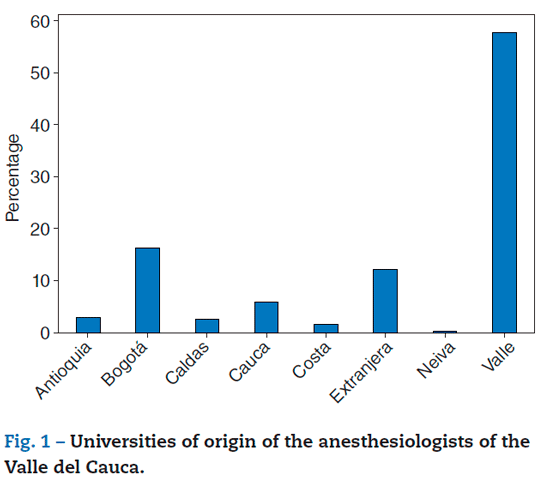
With regards to the use of NDNMB in general anesthesia, 9% of the anesthesiologists surveyed answered that they rarely use it, while 30% use it occasionally and 61% use it frequently, usually or always (fig. 2).
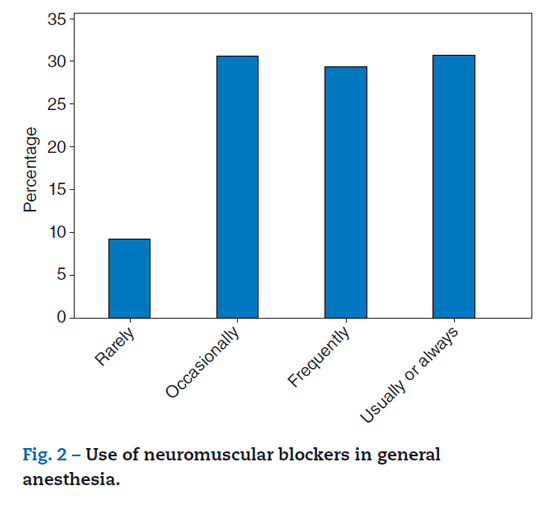
As regards NMBM, 68% of the anesthesiologists surveyed said they rarely used it, while only 13% said they used it frequently, usually or always (fig. 3).
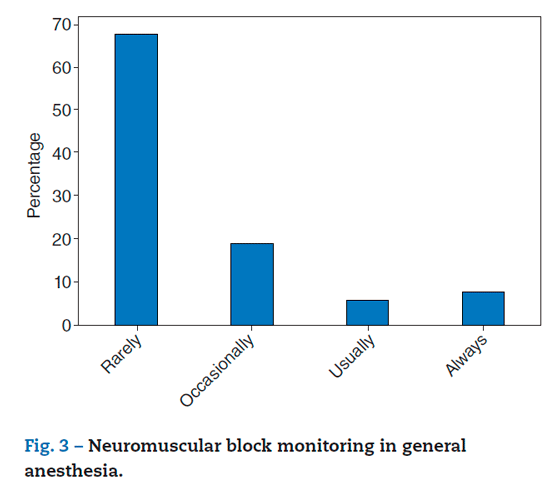
With regards to the question about the use of reversal agents when using NDNMB in general anesthesia, 32% and 25% of the anesthesiologists said they rarely or occasionally reversed the block, respectively; 24.7% and 17.8% said they
frequently, usually or always reversed the patients when using NDNMB, respectively (fig. 4).
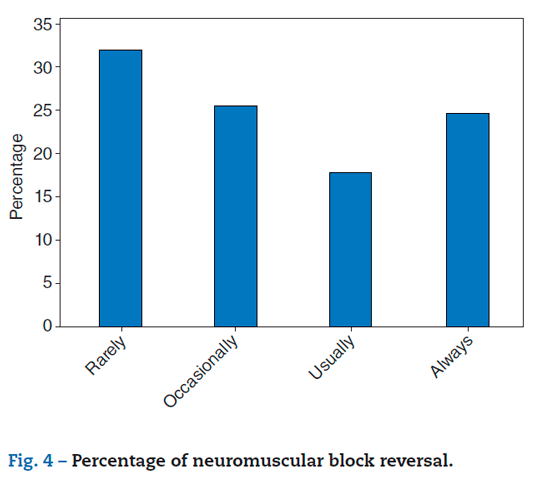
The activity in terms of the number of surgical procedures per year and the use of neostigmine units (vials) shown in figure 5, illustrates that in 2007, 76 vials were used per every 100 patients at the Institute for Blind and Deaf Children, whilst in 2009 there was a drop to 20 vials per 100 patients. The design of this paper prevents us from claiming a relationship between the trend to a declining consumption of neostigmine and the increase in general anesthesia, although this statement is consistent with the answers to the survey, which indicate that anesthesiologists continue to use NDNMB, but rarely use reversal agents.
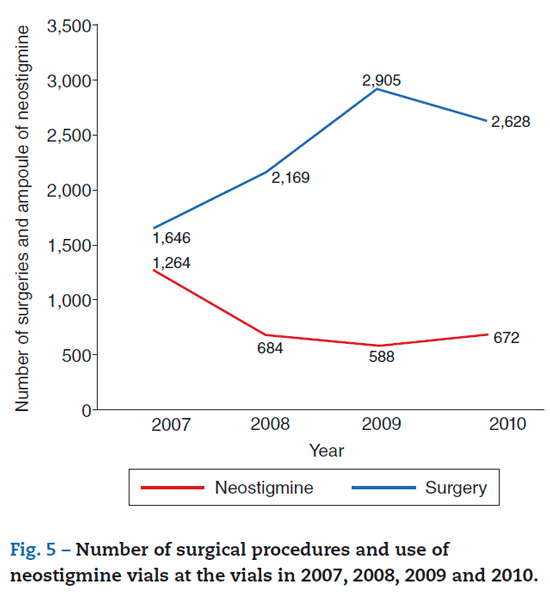
Discussion
The minimum safety standards of the Colombian Society of Anesthesiology and Resuscitation (SCARE) highly recommend NDNMB.3 Although a high prevalence of RB is still reported in the Postanesthetic Care Unit (PACU) (40%),7 the opinions of anesthesiologists on objective monitoring of neuromuscular block are quite variable.8 Knowledge on the use of these drugs has spurred important research throughout the years,9,10 however we are not aware of any of these studies
being performed in Colombia. In our environment, 91% of the anesthesiologists surveyed said they occasionally used NDNMB, 59% used it frequently and 32% usually or always; however, 68% said they rarely used neuromuscular block monitoring (NMBM). With regards to reversal of the NDNMB, 42.5% of the anesthesiologists claim to do it occasionally or rarely.
The limitation of this descriptive and cross-sectional study is that it prevents us from establishing associations with the usage patterns of NDNMBs. However, it does reflect the behavior of anesthesiologists in a particular region. It must be noted that according to the universities of origin, almost half of the doctors surveyed received their anesthesiology degree from universities in regions other than the Valle del Cauca, or graduated abroad. This fact leads us to consider the possibility for these results may reflect what happens around the country as a whole.
This reflection would be unnecessary if the RB were free of adverse effects and/or were not associated with complications. However, there is a broad spectrum of adverse effects, ranging from an unpleasant feeling of weakness, delayed discharge from the OR or the PACU, to respiratory depression that compromises the safety of our patients. The potential risks associated with RB can be serious for the lungs, including severe upper airway obstruction, atelectasis, pneumonia, and death.11,12 The ways to prevent the above effects range from avoiding the use of NDNMB and using the agents judiciously, including both NMBM and the availability of reversal agents. In our country, the most widely used drug is neostigmine, but there are some questions on the use of this product; i.e., its association with cardiovascular complications, recurarization, and increased postoperative nausea and vomiting.13
None of these situations is new,14,15 however, there is considerable room for improvement in controlling the preventable adverse events associated with RB, including establishing clear rules on the need to monitor and record any residual block and encourage the availability of the new reversal agents, as well as implementing educational campaigns. A review of the trends with regards to the use of neostigmine versus the number of surgical procedures performed under general anesthesia at an Institution in Valle del Cauca showed that the use of the reversal agent has declined, although the number of general anesthesia procedures increased within the same time period (20072010). Although the limitations of the study prevent us from establishing the cause of these two trends, in terms of safety one must consider a possible decline in the use of non-depolarizing neuromuscular block. An additional limitation is a probable information bias that we tried to avoid with the design of the trial and the test tool, in addition to the selection of the population.
In summary, the use of NDNMB in general anesthesia is frequent in our environment, but monitoring is unusual. The reasons for such low frequency of NMBM may be several, including the non-availability of monitoring equipment, poor knowledge on how to do it or interpret the monitoring, or the anesthesiologist believes in the safety of the so called "short" or "intermediate" lasting blocking agents. The comparison between the number of surgeries and the use of neostigmine
at the INCS in the last four years reveals a decline in the use of NDNMB reversal agents, and this is consistent with results of the survey showing that 57.5% of the anesthesiologists rarely use reversal agents or use them only occasionally.
With a 40% RB prevalence worldwide, how many RB patients are admitted to our PACUs? And, how many preventable adverse events occur? What is the rule to determine appropriate NDNMB recovery? This study highlights the risk associated with the use of NDNMB and the potential preventable complications, probably as a result of poor monitoring or the false belief that anesthesiologists have with regards to the safety of medium or intermediate acting blockers. An educational campaign to address the pharmacokinetics of NDNMBs and their antagonists may help in developing safety standards for the use of NDNMBs;16 for instance, obligatory monitoring,17 or the implementation of recommendations on the use or reversal agents.
Conclusions
The use of neuromuscular blockers in general anesthesia is a current practice in our environment.
Monitoring of neuromuscular blockade is unusual among the anesthesiologists who practice in Valle del Cauca.
The use of neostigmine has dropped in the last 4 years at the INCS.
The use of neuromuscular blockers is potentially risky in our environment. Decreased reversal and infrequent monitoring may be placing our patients at risk of a morbidity-mortality resulting from the use of these drugs.
Funding
Author's own resources.
Conflict of interests
None declared.
REFERENCES
1. Kopman AF, Eikermann M. Antagonism of non-depolarizing neuromuscular block: Current practice. Anesthesia. 2009;64 Suppl 1:22-30.
2. Brechner VL. Clinical syndrome of incomplete neuromuscular block reversal: doctor, look at your patient. Anesth Analg. 1971;50:876-8.
3. Normas mínimas para el ejercicio de la Anestesiología en Colombia. Comité de seguridad. 2009. Disponible en: URL www.scare.org.co Consultado el 10 de febrero de 2011.
4. Baillard C. Incidence and complications of postoperative residual paralysis. Ann Fr Anesth Reanim. 2009;28 Suppl 2: S41-5.
5. Cammu G, De Witte J, De Veylder J, Byttebier G, Vandeput D, Foubert L, et al. Postoperative residual paralysis in outpatients versus inpatients. Anesth Analg. 2006;102:426-9.
6. Fuchs-Buder T, Meistelman C. Monitoring of neuromuscular block and prevention of residual paralysis. Ann Fr Anesth Re-anim. 2009;28 Suppl 2:S46-50.
7. Murphy GS, Bully SJ. Residual neuromuscular block: lessons unlearned. Part I: definitions, incidence, and adverse physiologic effects of residual neuromuscular Block Anesth Analg. 2010;111:120-8.
8. Smith A. Monitoring of neuromuscular blockade in general anesthesia. Lancet. 2010;10;376:77-9.
9. Mirakhur RK. A survey of practice of neuromuscular block in the United States and Europe. Anesth Analg. 2011;112:481; author reply 482-3.
10. Klessig HT, Geiger HJ, Murray MJ, Coursin DB. A national survey on the practice patterns of anesthesiologist intensivists in the use of muscle relaxants. Crit Care Med. 1992;20:1341-5.
11. Herbstreit F, Peters J, Eikermann M. Impaired upper airway integrity by residual neuromuscular blockade: increased airway collapsibility and blunted genioglossus muscle activity in response to negative pharyngeal pressure. Anesthesiology. 2009;110:1253-60.
12. Fuchs-Buder T, Eikermann M. Residual neuromuscular blockades. Clinical Consequences, frequency and avoidance strategies. Anesthetist. 2006;55:7-16.
13. Mizikov VM, Stamov VI, Deshko IV, Ialich A. Problem of neu-romuscular block Reversion: neostigmine and sugammadex. Anesteziol Reanimatol. 2010;(2):40-3.
14. Bevan DR, Bevan JC. Residual postoperative paralysis. Yes, it does matter. Anesthesiology. 1997;86:1215-6.
15. Caldwell JE. Clinical limitations of acetyl cholinesterase antagonists. J Crit Care. 2009;24:21-8.
16. Medina RS, Sánchez AM, Oquendo FG. Sugammadex en un paciente con insuficiencia renal crónica. Rev Colomb Anestesiol. 2011:39: 433-9.
17. Kopman AF. Neuromuscular monitoring: old issues, new controversies. J Crit Care. 2009;24:11-20.
1. Kopman AF, Eikermann M. Antagonism of non-depolarizing neuromuscular block: Current practice. Anesthesia. 2009;64 Suppl 1:22-30. [ Links ]
2. Brechner VL. Clinical syndrome of incomplete neuromuscular block reversal: doctor, look at your patient. Anesth Analg. 1971;50:876-8. [ Links ]
3. Normas mínimas para el ejercicio de la Anestesiología en Colombia. Comité de seguridad. 2009. Disponible en: URL http://www.scare.org.co Consultado el 10 de febrero de 2011. [ Links ]
4. Baillard C. Incidence and complications of postoperative residual paralysis. Ann Fr Anesth Reanim. 2009;28 Suppl 2: S41-5. [ Links ]
5. Cammu G, De Witte J, De Veylder J, Byttebier G, Vandeput D, Foubert L, et al. Postoperative residual paralysis in outpatients versus inpatients. Anesth Analg. 2006;102:426-9. [ Links ]
6. Fuchs-Buder T, Meistelman C. Monitoring of neuromuscular block and prevention of residual paralysis. Ann Fr Anesth Reanim. 2009;28 Suppl 2:S46-50. [ Links ]
7. Murphy GS, Bully SJ. Residual neuromuscular block: lessons unlearned. Part I: definitions, incidence, and adverse physiologic effects of residual neuromuscular Block Anesth Analg. 2010;111:120-8. [ Links ]
8. Smith A. Monitoring of neuromuscular blockade in general anesthesia. Lancet. 2010;10;376:77-9. [ Links ]
9. Mirakhur RK. A survey of practice of neuromuscular block in the United States and Europe. Anesth Analg. 2011;112:481; author reply 482-3. [ Links ]
10. Klessig HT, Geiger HJ, Murray MJ, Coursin DB. A national survey on the practice patterns of anesthesiologist intensivists in the use of muscle relaxants. Crit Care Med. 1992;20:1341-5. [ Links ]
11. Herbstreit F, Peters J, Eikermann M. Impaired upper airway integrity by residual neuromuscular blockade: increased airway collapsibility and blunted genioglossus muscle activity in response to negative pharyngeal pressure. Anesthesiology. 2009;110:1253-60. [ Links ]
12. Fuchs-Buder T, Eikermann M. Residual neuromuscular blockades. Clinical Consequences, frequency and avoidance strategies. Anesthetist. 2006;55:7-16. [ Links ]
13. Mizikov VM, Stamov VI, Deshko IV, Ialich A. Problem of neuromuscular block Reversion: neostigmine and sugammadex. Anesteziol Reanimatol. 2010;(2):40-3. [ Links ]
14. Bevan DR, Bevan JC. Residual postoperative paralysis. Yes, it does matter. Anesthesiology. 1997;86:1215-6. [ Links ]
15. Caldwell JE. Clinical limitations of acetyl cholinesterase antagonists. J Crit Care. 2009;24:21-8. [ Links ]
16. Medina RS, Sánchez AM, Oquendo FG. Sugammadex en un paciente con insuficiencia renal crónica. Rev colomb anestesiol. 2011;39: 433-9. [ Links ]
17. Kopman AF. Neuromuscular monitoring: old issues, new controversies. J Crit Care. 2009;24:11-20. [ Links ]











 texto en
texto en 

